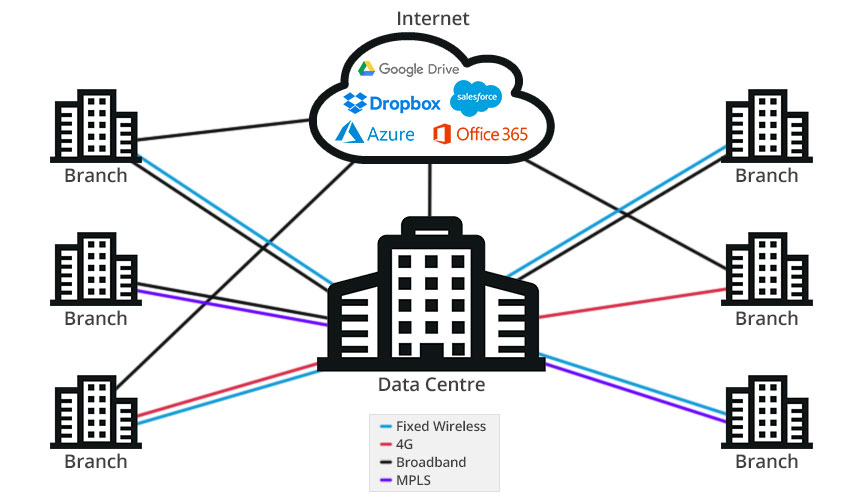The cloud has created a new set of challenges for networking professionals. One of the biggest challenges is how to connect users to applications with the best possible performance while still reducing costs.
This has led to the rise of SD-WAN systems, which is a software-defined approach to WAN connectivity that offers many benefits over traditional WANs. In this article, we’ll take a look at the different types of SD-WAN and how they can be used to meet your networking needs.
You are looking for a solution to improve your business connectivity, but you don’t know what SD-WAN is or how it works.
The internet is changing and evolving. You need to stay up-to-date with the latest trends in order to keep your business competitive.
Learn more about the different types of SD-WAN solutions on our blog!
What are the Types of SD-WAN?

1. On-prem-only
An “on-prem-only” SD-WAN architecture is built on top of already existing WAN infrastructure. These solutions are delivered solely as software that runs on existing hardware. This is the most common type of SD-WAN solution and is ideal for organizations with existing WAN infrastructure that want to improve their performance.
Benefits Cloud-enabled
- A cloud-enabled business can improve its agility, efficiency, and competitiveness while reducing costs.
- Cloud-based applications and services can help businesses to be more agile and responsive to market changes and customer needs.
- Cloud computing can help businesses to improve their operational efficiency and reduce their IT costs.
- Lower costs than an all-new solution, immediate effect, and quick ROI.
2. Cloud-enabled
In a cloud-enabled SD-WAN architecture, the solution leverages a robust cloud infrastructure to deliver SD-WAN functionality. Benefits Costs are lower than an all-new solution, no existing WAN infrastructure is required, and the ability to scale.
SD-WAN as a service SD-WAN as a service is delivered in the same way that cloud services are delivered. A third party controls the SD-WAN solution and provides all of the hardware, software, and data center infrastructure.
Benefits of Cloud-enabled
- There are many benefits of cloud-enabled devices and applications.
- One of the primary benefits is that users can access their data from any location.
- Another benefit is that cloud-based systems are typically more reliable than on-premises systems.
- Additionally, cloud-based systems can be scaled up or down as needed, so businesses only pay for the resources they use.
3. Cloud-enabled plus backbone
Cloud-enabled SD-WAN architecture can Costs are lower than an all-new solution, no existing WAN infrastructure is required, and the ability to scale. Leverages a robust cloud infrastructure to deliver SD-WAN functionality. Integrated with other cloud applications and services for easy integration into your business.
The cloud-enabled plus backbone provides a comprehensive and secure network that helps to keep businesses connected. The cloud-based system offers many benefits, including:
Benefits of Cloud-enable
1. Increased Flexibility and Scalability
With the cloud-enabled plus backbone, businesses can easily scale up or down as needed, without having to make major infrastructure changes. This makes it ideal for businesses that experience seasonal fluctuations or sudden growth spurts.
2. Cost Savings
The cloud-enabled plus backbone can help businesses save money on hardware and maintenance costs. Additionally, by consolidating data and applications onto a single platform, businesses can further reduce their IT expenses.
3. Enhanced Security
The cloud-enabled plus backbone features robust security measures that protect businesses’ data and applications from unauthorized access and theft.
What are the Basic SD-WAN Features?
A software-defined wide area network (SD-WAN) is a type of WAN that uses software to define how traffic is routed over an underlying network. This can provide many benefits, including improved performance, reduced costs, and increased flexibility. There are several key features that are typically included in an SD-WAN solution.
- These can include things like traffic shaping and Quality of Service (QoS), which can help to optimize performance.
- Additionally, most SD-WAN solutions will offer some form of security, either through built-in features or by integrating with existing security solutions.
- Finally, many SD-WAN solutions also offer management and monitoring tools to help administrators troubleshoot issues and ensure that the network is operating as intended.
Is SD-WAN a Layer 7?
If you’ve been wondering whether SD-WAN is a Layer 7, the answer is both yes and no. Here’s a closer look at how SD-WAN works and how it fits into the Layer 7 structure. SD-WAN is a software-defined networking solution that uses multiple WAN connectivity types to create a single, logical network.
It’s sometimes referred to as a “virtual WAN” because it abstracts away the physical underlying WAN infrastructure. So, yes, SD-WAN is technically a Layer 7 solution. But it’s important to understand that SD-WAN doesn’t replace your existing WAN infrastructure. Rather, it sits on top of it and provides an added layer of abstraction and flexibility.
Is SD-WAN layer 3?
Layer 3 SD-WAN is a type of software-defined wide area network (SD-WAN) that uses both public and private IP addresses to route traffic between sites.
Layer 3 SD-WAN connects sites using Layer 3 protocols such as Border Gateway Protocol (BGP). BGP is a routing protocol that uses various attributes to determine the best path for data packets.
Layer 3 SD-WAN provides many benefits over traditional WANs, such as increased flexibility, improved performance, and reduced costs. One of the main benefits of Layer 3 SD-WAN is its ability to support multiple connection types, including MPLS, Internet, and 4G/LTE. This allows businesses to take advantage of different WAN services depending on their needs.
Final Words
In conclusion, there are three main types of SD-WAN: overlay, hub and spoke, hybrid, and meshed. All four have their own set of benefits and drawbacks that make them suitable for different types of businesses. It’s important to do your research to figure out which type of SD-WAN is right for your organization.
